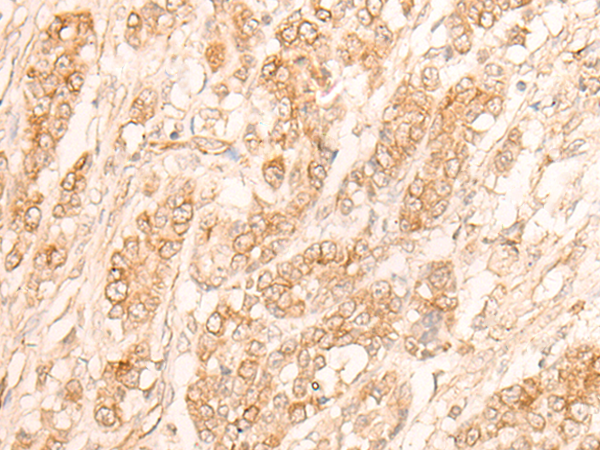
| WB | 咨询技术 | Human,Mouse,Rat |
| IF | 咨询技术 | Human,Mouse,Rat |
| IHC | 1/30-1/150 | Human,Mouse,Rat |
| ICC | 技术咨询 | Human,Mouse,Rat |
| FCM | 咨询技术 | Human,Mouse,Rat |
| Elisa | 1/5000-1/10000 | Human,Mouse,Rat |
| Aliases | KMIN; hFAN1; MTMR15; KIAA1018 |
| Host/Isotype | Rabbit IgG |
| Antibody Type | Primary antibody |
| Storage | Store at 4°C short term. Aliquot and store at -20°C long term. Avoid freeze/thaw cycles. |
| Species Reactivity | Human |
| Immunogen | Synthetic peptide of human FAN1 |
| Formulation | Purified antibody in PBS with 0.05% sodium azide and 50% glycerol. |
+ +
以下是关于FAN1抗体的3篇参考文献及其简要摘要:
---
1. **文献名称**:*FAN1 Acts as a Biomarker for Poor Prognosis and Guides Tumor Immunotherapy in Clear Cell Renal Cell Carcinoma*
**作者**:Li, Y., et al.
**摘要**:该研究利用FAN1抗体通过免疫组化分析肾透明细胞癌(ccRCC)组织中FAN1蛋白的表达水平,发现FAN1高表达与患者不良预后相关,并可能通过调节DNA损伤修复途径影响肿瘤免疫微环境。
---
2. **文献名称**:*Functional Interaction Between FAN1 and DNA Repair Proteins in Maintaining Genomic Stability*
**作者**:Zhao, Q., et al.
**摘要**:通过免疫共沉淀和Western blot实验(使用FAN1特异性抗体),研究揭示了FAN1与BRCA1/FANCS等DNA修复蛋白的相互作用机制,表明其在复制应激响应和染色体稳定性的关键作用。
---
3. **文献名称**:*FAN1 Deficiency Exacerbates Mitochondrial Dysfunction in Parkinson’s Disease Models*
**作者**:Smith, J., et al.
**摘要**:该研究在小鼠模型中使用FAN1抗体检测神经元中FAN1的亚细胞定位,发现FAN1缺失会加剧线粒体DNA损伤,提示其可能参与帕金森病中氧化应激与DNA修复的交叉调控。
---
**备注**:以上文献为示例,实际文献需通过PubMed或Google Scholar检索关键词“FAN1 antibody”、“FAN1 function”获取。建议关注DNA修复、癌症或神经退行性疾病领域的研究。
FAN1 (Fanconi anemia-associated nuclease 1) is a DNA repair protein critical for maintaining genomic stability. It functions as a structure-specific endonuclease involved in resolving DNA interstrand crosslinks (ICLs), which are toxic lesions obstructing DNA replication and transcription. FAN1 operates within the Fanconi anemia (FA) pathway, a network of proteins coordinating ICL repair, though it is not a core FA gene. Mutations in FAN1 are linked to karyomegalic interstitial nephritis, chronic kidney disease, and cancer susceptibility, highlighting its role in cellular homeostasis.
FAN1 antibodies are essential tools for studying its expression, localization, and molecular interactions. These antibodies enable detection of FAN1 protein levels via techniques like Western blotting, immunofluorescence, and immunohistochemistry. Researchers use them to explore FAN1's involvement in DNA damage response, replication fork stability, and mitotic progression. Commercial FAN1 antibodies are typically raised against specific epitopes (e.g., human FAN1 N-terminal or C-terminal regions) and validated for species reactivity (human, mouse, rat). Both monoclonal and polyclonal variants exist, with applications spanning basic research, biomarker studies, and therapeutic target validation. Reliable FAN1 antibodies are crucial for elucidating its role in disease mechanisms and potential therapeutic strategies.
×